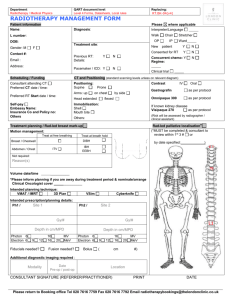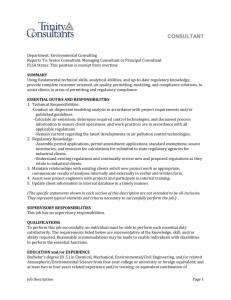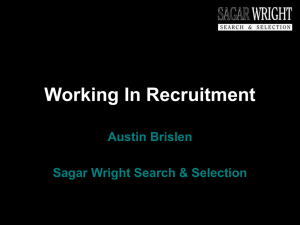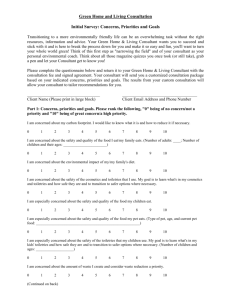E3044 rev NATIONAL ENVIRONMENTAL MANAGEMENT
advertisement
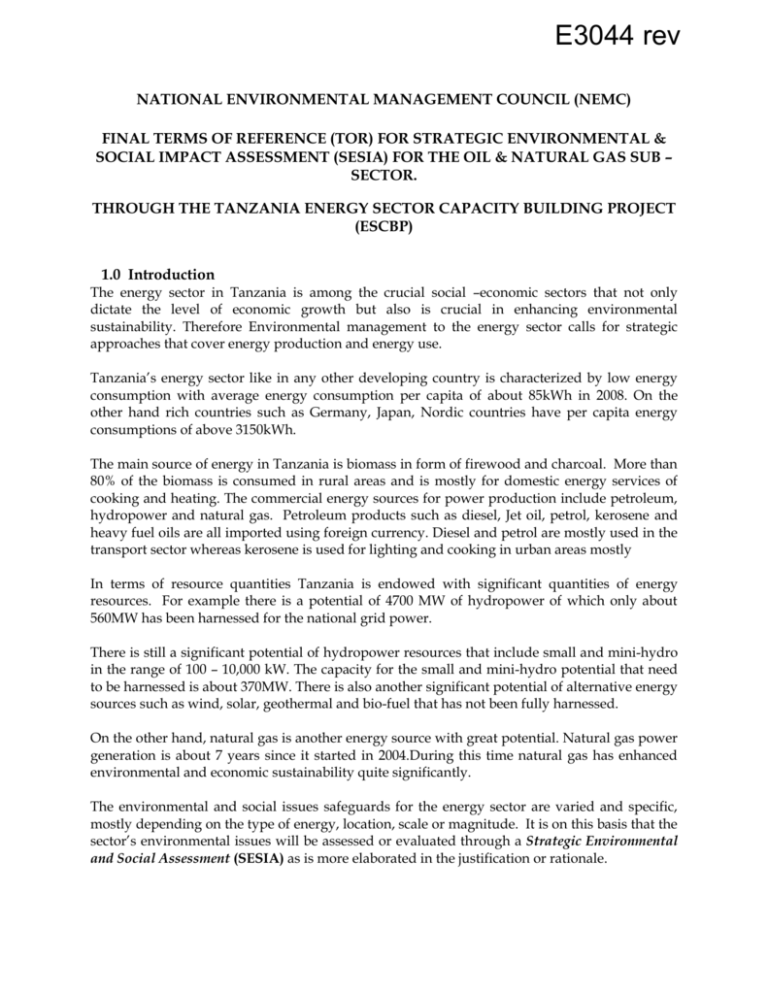
E3044 rev NATIONAL ENVIRONMENTAL MANAGEMENT COUNCIL (NEMC) FINAL TERMS OF REFERENCE (TOR) FOR STRATEGIC ENVIRONMENTAL & SOCIAL IMPACT ASSESSMENT (SESIA) FOR THE OIL & NATURAL GAS SUB – SECTOR. THROUGH THE TANZANIA ENERGY SECTOR CAPACITY BUILDING PROJECT (ESCBP) 1.0 Introduction The energy sector in Tanzania is among the crucial social –economic sectors that not only dictate the level of economic growth but also is crucial in enhancing environmental sustainability. Therefore Environmental management to the energy sector calls for strategic approaches that cover energy production and energy use. Tanzania’s energy sector like in any other developing country is characterized by low energy consumption with average energy consumption per capita of about 85kWh in 2008. On the other hand rich countries such as Germany, Japan, Nordic countries have per capita energy consumptions of above 3150kWh. The main source of energy in Tanzania is biomass in form of firewood and charcoal. More than 80% of the biomass is consumed in rural areas and is mostly for domestic energy services of cooking and heating. The commercial energy sources for power production include petroleum, hydropower and natural gas. Petroleum products such as diesel, Jet oil, petrol, kerosene and heavy fuel oils are all imported using foreign currency. Diesel and petrol are mostly used in the transport sector whereas kerosene is used for lighting and cooking in urban areas mostly In terms of resource quantities Tanzania is endowed with significant quantities of energy resources. For example there is a potential of 4700 MW of hydropower of which only about 560MW has been harnessed for the national grid power. There is still a significant potential of hydropower resources that include small and mini-hydro in the range of 100 – 10,000 kW. The capacity for the small and mini-hydro potential that need to be harnessed is about 370MW. There is also another significant potential of alternative energy sources such as wind, solar, geothermal and bio-fuel that has not been fully harnessed. On the other hand, natural gas is another energy source with great potential. Natural gas power generation is about 7 years since it started in 2004.During this time natural gas has enhanced environmental and economic sustainability quite significantly. The environmental and social issues safeguards for the energy sector are varied and specific, mostly depending on the type of energy, location, scale or magnitude. It is on this basis that the sector’s environmental issues will be assessed or evaluated through a Strategic Environmental and Social Assessment (SESIA) as is more elaborated in the justification or rationale. 2.0 Justification/Rationale The production and consumption of almost any type of energy is associated with a variety of impacts on the natural and human environments. The significance and scale of the impact depends on the nature of the energy type, location and scale. At global level energy activities give rise to undesirable phenomena such as climate change which is a result of increased greenhouse gases (GHG) concentrations to the atmosphere that has consequently led to global warming which causes climate change. The impacts of climate change include; sea level rise, floods and drought. These impacts are detracting the process of sustainable development. At the level of energy type, natural gas which is the focus of the present SESIA study is among energy sources with less greenhouse gas emissions. Natural gas is petroleum or fossil based fuel product. Natural gas or petroleum extraction can be organized into four wide sectors or areas. These areas include; exploration and production of crude oil and natural gas, transportation, refining/processing and distribution/ marketing. The respective activities of all these areas have significant impacts; air quality degradation, generation of toxic and hazardous material, respiratory and other illnesses, as well as safety hazards. Furthermore, during extraction, biodiversity both terrestrial and marine environments is impacted. Biodiversity impacts in terrestrial environment in turn have social and economic impacts -- they affect people’s quality of life and their livelihoods in agriculture, forestry, air quality, water and land resources -- whereas biodiversity impacts in marine environment affect fishing and marine water quality. On the other hand, there are a number of positive impacts which include employment opportunities, expansion of health services, roads, electricity, energy security and other business opportunities. The main challenge is to make sure that positive impacts are enhanced and negative impacts are properly mitigated. These objectives have typically been addressed at the individual project level, through preparation of environmental and social impact assessments (ESIA) in accordance with Tanzanian law and regulations, and this practice will continue. It can be made more efficient and effective, however, through a sector-wide examination of potential impacts, leading to preparation of guidelines to improve not only the analytical aspects of projectspecific ESIAs but also the impact management approaches and measures that will be applied in developments in the sector. There are also opportunities to integrate principles of sustainable development “upstream” so that they influence timely decision-making in the process. These cannot readily be exploited at the level of project-specific ESIAs because they involve the establishment or formulation of instruments for the entire sector, such as new regulations, or good practice guidelines for planning and managing development. The solution is to undertake a Strategic Environmental & Social Impact Assessment – SESIA -- for the oil and natural gas sub- sectors. The SESIA is important now due to the current activities in oil and natural gas exploration/extraction and uses. Activities in the oil and natural gas subsector have been intensified significantly during the last seven years. For example during the last three years, about 25 PSA (Production Sharing Agreements) have been set up between Tanzania and prominent international oil and gas companies. Furthermore there are already productive natural gas fields at Songosongo and Mnazi Bay. Natural gas reserves at Songosongo are about 689 billion cubic feet (bcf) (whereas Mnanzi Bay has a proven reserve of 1540bcf. The other fields include; Mkuranga, Kiliwani, Njuani with an estimated combined potential reserve volume of 10 terra cubic feet for extraction as part of the upstream activities. The natural gas utilization will not be limited to the downstream use of power generation; also natural gas will be used in the transport sector, and in fertilizer manufacture that has potential to expand agricultural businesses. Natural gas will also be converted to Liquid Natural Gas (LNG) for export. The scope of environment and social impact management for the natural gas including oil is very wide covering both the terrestrial and marine environments. With regard to terrestrial environment, there are a variety of sectors such as agriculture, forestry, transport and other land uses – all of which have specific sectoral environmental social issues. On the other hand, the marine environment has also specific broad sectors such as fishing and transport which have specific environmental management issues as well. From the foregoing a Strategic Environmental and Social Impact Assessment (SESIA) will broadly integrate environmental and social concerns into the oil and gas development for its long term sustainable development. The SESIA will be closely linked to the Energy Sector Capacity Building Project (ESCBP) which is being implemented by Ministry of Energy and Minerals (MEM), among others, and supported by the World Bank. ESCBP has the following five components. Component A: Petroleum Policy and Legal Framework o A1. Petroleum Policy and Strategy o A2. Legal and Regulatory Framework Component B: Strengthening Institutional Sector Management, Coordination and Governance o B1. Strengthen Sector Coordination and Governance o B2. Enhancing Organizational Capacity o B3. Environmental Management o B4. Safety Management Component C: Education and Skills Development Component D: Large Power Generation and Natural Gas PPP Projects Capacity o D1. MEM PPP Unit Support o D2. TANESCO PPP Unit Support Component E: Project Coordination Component A focuses on the GoT´s priority of implementing a comprehensive, clear and workable regulatory framework for the development of Tanzania’s gas resources. Component B aims at strengthening the capacity of the major institutions that deal with the oil and gas sector as well as the power generation sector to allow them to execute their mandates in a way that is conducive to investments and ensures that all environmental safeguards and safety standards are met to international standards. Component C focuses on enhancing technical skills in the sector through support to VETA. Component D will increase the capacity of the GoT and its institutions to attract and develop large power generation projects with private sector sponsors/financing. Finally, Component E will support Project coordination among the various implementing agencies. Preparation of the SESIA is a task in Sub-component B3, but its results will inform many of the activities in Components A through D. A lead stakeholder in the SESIA process, especially if its results include recommendations for new regulations or legislation, is the Vice President’s Office-Division of Environment (VPODoE). Another key stakeholder is the Ministry of Energy and Minerals (MEM) which is the National Coordinator for the Energy Sector Capacity Building Project (ESCBP). 3.0 Objective Prepare a Strategic Environmental and Social Impact Assessment (SESIA) that will provide guidance to NEMC, MEM and VPO on systematically integrating environmental and socioeconomic concerns in policy, regulation and planning, project development, operations and maintenance of oil and gas sector activities. Furthermore, the SESIA will provide a benchmark for cumulative environmental and social effects with other on- going sector programmes and plans in both the terrestrial and marine environments. More significantly the SESIA will ensure that all concerns and expectations by different stakeholders are taken on board in the decision making process for equity and sustainable development of the oil and gas sub-sector in Tanzania. The SESIA will explore the environmental and social issues associated with oil and gas development and utilization and formulate technical, institutional, regulatory, legislative and policy recommendations to address those issues. As a starting point for identification of impacts and mitigation measures, NEMC will re-examine the Environmental Impact Assessment Studies (EIAs) that have been reviewed for both upstream and downstream oil and natural gas projects during the last five years. NEMC’s main objective on the EIAs is to evaluate the effectiveness of the respective Environment Management Plans (EMPs) to achieve the sustainable development goals in the oil and gas sub-sector. Other sources of information will also be tapped, including industry experts, NGOs, and academic institutions to ensure that any pertinent issues that were not identified in the EIAs will be taken into consideration in the SESIA. The starting point for consideration of sector-wide issues of policy, planning, regulation and institutional capacity will be a thorough assessment of the present legal, regulatory, administrative and institution framework within this oil and gas developments proceed. 4.0 Terms of Reference (ToR) The consultant will conduct the preparation of the SESIA in five stages: scoping; identification of impacts and issues; description of the regulatory and institutional framework and assessment of capacity; formulation of recommendations; and final consultations, review and approval. The consultant will prepare interim outputs at the end of each stage, to be compiled into a draft report for final consultations, a final draft for review, and eventually a final report. In addition, the consultant will be available on request to advise on the environmental and social implications of policy and regulatory options that will be developed in ESCBP Components A.1 and A.2. NEMC will supervise the consultant’s work, assisted by experts from the VPO and by the International Environmental Advisor that will be procured on periodic consultancy terms under ESCBP Component B.3. The consultant will also coordinate relevant parts of the work with the International Safety Advisor that ESCBP is providing to OSHA under Component B.4. Throughout the project, the consultant will maximize opportunities for transferring knowledge of international best practice to increase the capacities of NEMC, VPO and MEM to undertake SESIA. The stages and their component tasks are described below. 4.1 Scoping The objective of Scoping is to frame the content and methodology of the SESIA, with substantial stakeholder inputs, based on the consultant’s preliminary reviews of: environmental and social impact management experience in the sector; trends and plans for oil and gas development; the legal, regulatory and institutional framework with which the sector operates; and an overview of the environmental and social characteristics of the areas that are most likely to be affected by sector activities. The Scoping Stage would require eight (8) weeks. The individual tasks are described below. 1. Review the ESIAs and Environmental Management Plans (EMPs) of different projects in both the Marine and Terrestrial environments i.e. off-shore and on-shore during the last 5 years. The reports and assessments of the effectiveness of EMP implementation will be provided by NEMC. 2. Assemble preliminary information relevant to the scope of the ESIA, including but not limited to: plans and trends in oil and gas development that are likely to have environmental or social impacts; the policy, legal, regulatory and institutional framework for the sector; and the main stakeholders that should be consulted. 3. The Consultant will identify the key stakeholders in the oil and gas sector and analyse their interests and incentives. The intent of the stakeholder analysis is to identify the main interest groups that prevail in the sector and to formulate a work plan for consultations that will ensure their interests; concerns and advice are taken into account in the SESIA. 4. Prepare a draft report covering the proposed scope of the SESIA, the table of contents for the SESIA report, the schedule and methodology for conducting the work, and plans for stakeholder consultation. 5. Conduct scoping workshops. SESIA is a participatory process that will involve relevant stakeholders, both to develop understanding and ownership of the process and to obtain valuable inputs. Accordingly there will be three workshops and site visits to both off-shore and on-shore oil and gas producing areas national wide. The Workshops will engage consultations with stakeholders; e.g. sectors of fisheries, agriculture, transport, marine parks and forestry, as well as industry groups, interested NGOs, and representatives of regional and district governments. 6. Prepare the final Scoping Report, incorporating workshop results, for review by NEMC, VPO, MEM and other relevant agencies and the World Bank. The Scoping Report will serve as the consultant’s inception report and should therefore include: (i) the institutional arrangements and timing agreed with NEMC, VPO, MEM and other key counterparts to carry out the SESIA; (ii) the SESIA work plan describing the main activities for data collection and analysis, including consultation/validation with stakeholders; and, (iii) the expected products and reports schedule to be submitted to MEM and copied to NEMC. 4.2 Identification of Environmental and Social Impacts and Issues and Mitigation measures Possible 7. The consultant will compile a list of the environmental and social impacts and issues relevant to the sector and potentially affected parts of Tanzania. This requires that the Consultant develops criteria to prioritize environmental and social issues in the context of Tanzania. To the extent possible, the criteria used must allow for quantification to objectively compare and categorize competing issues. Environmental and social priorities will be identified based on secondary data, case studies, environmental impact assessments, expert judgment, and priority environmental concerns of stakeholders. Cumulative impacts will be considered as well as impacts of individual developments in the sector. Potential mitigation measures and monitoring requirements will be identified for each potential impact. The consultants will combine the outputs of this stage with that of stage 4.3 described below and produce an interim report. This stage is expected to require ten (10) weeks. 4.3 Description of the Regulatory and Institutional Framework and Assessment of Capacity 8. The consultant will prepare a compilation of relevant policies, laws, regulations, and guidelines. 9. The Consultant will identify the institutions active in planning and carrying out development in the sector and those that are responsible for sectoral governance. 10. The consultant will assess the adequacy of the framework, based on international and Tanzanian experience, and the capacity of public agencies at national, sub-national and local levels, the oil and gas industry, and non-governmental organizations at national and community levels to address the potential impacts of gas development. The assessment will be carried out at two levels. At the national level, it will focus on relevant energy and environmental sector institutions within the government. For public agencies at subnational and local levels, the oil and gas industry and NGOs, the assessment will be mainly based on existing environmental impact assessments and case studies and complemented by in-depth interviews with key informants and there will be focus group discussions with vulnerable stakeholders. The results of this stage, which is expected to require ten (10) weeks partially overlapping stage 4.2, will be combined with those of stage 4.2 (above) into an interim report. Keeping the focus of the assessment on the effects of sector policy and regulatory development and on environmental and social issues, the following institutional and governance issues will be covered by the consultant: Gap analysis of mandates, capacity, incentives and transparency in permitting, monitoring and enforcing environmental regulations in the oil and gas sector. Expenditure review of sector and environmental institutions for environmental and social regulation and enforcement in the sector. Capacity and transparency of institutions at the central and local level to resolve controversies between landowners and water users in both off-shore and on-shore sites. Coordination between oil and gas and environment and natural resource management institutions. Accountability of decision makers and authorities with competence for granting environmental permits to oil and gas activities. Organizational and institutional capacity of stakeholders affected by or vulnerable to activities in the oil and gas sector. 11. Conduct consultations on the interim report through 2 national workshops. These workshops must serve to capture the perceptions of relevant stakeholders on environmental and social priorities related to gas development, and on the corresponding proposed government interventions or policies needed to address them. The Consultant must ensure that the perceptions of weaker and vulnerable stakeholders are taken into account and incorporated into the analysis. Upon completion of the workshop, the consultant will revise the first interim report and submit it for review by NEMC, MEM, VPO and the World Bank. 4.4 Formulation of Recommendations 12. The consultant will draft the technical recommendations. These will consist of but not be limited to a free-standing set of guidelines for development planning, ESIA and impact management in the sector, including guidance in identifying and managing cumulative impacts, and any recommended additions to or changes in Tanzanian environmental standards governing the sector. The consultant should apply experience and judgment in identifying other appropriate technical outputs. 13. The consultant will identify necessary changes in or additions to policy, legislation, regulations and guidelines and a policy, legislative, and regulatory matrix comprising recommendations and an action plan for their implementation and monitoring. 14. The consultant will draft a plan for capacity-building, including changes in or additions to the existing institutional structure and institutional development, also formulate a matrix of recommendations and an action plan. 15. The sectoral guidelines will be a free-standing document. The other outputs of this stage will be compiled into a second interim report for review by NEMC, VPO, MEM and the Bank. Stage 4.4 is expected to require six (6) weeks. 4.5 Final Consultations, Review and Approval 16. The consultant will combine the interim reports and key elements of the scoping report into a draft report for dissemination to stakeholders by NEMC. 17. The consultant will present the draft final report at three workshops – one national and two regional to obtain stakeholder comments. NEMC will organize the workshops. 18. Following the workshops, the consultant will revise the draft report based on stakeholder inputs, document the consultations and their results in the report, and submit a draft final report to NEMC, VPO and MEM with a copy to World Bank, for review and approval. 19. The consultant will prepare the final report, incorporating all revisions suggested. Tasks 16 through 19 are expected to require eight (8) weeks, allowing time for review of the draft final report by stakeholders prior to the workshops. The Consultant may be required to participate in key follow-up discussions necessary to further disseminate and explain the findings and recommendations of the SESIA, particularly to the government and donor community. 4.6 Additional Advisory Services and Knowledge Transfer 20. The consultant should include in its proposal provision of six person-weeks of specialized assistance to NEMC, MEM and VPO in assessing the potential environmental and social impacts of policy, legislative, or regulatory changes that may be under consideration in ESCBP Component A. 21. The consultant should include in its proposal arrangements for transfer of knowledge on sectoral and strategic environmental and social assessments to NEMC, MEM and VPO staffs. These can include on the job training, presentations of international experience, and visits to countries that have experience with these forms of impact assessment, such as Ghana, Angola, and Malaysia or any other country that the Consultant may propose. 5.0 Consultant’s Qualification The SESIA will be undertaken by a team composed of international and local environmental consulting company with extensive energy sector experience that will have the lead responsibility for data collection and analytical work, with extensive experience in public participation and consultation. The international team will provide overall coordination and advisory services to the local consultants. The minimum qualifications of key team members are as follows: Environmental specialist (international) with at least ten years of professional experience, at least five of which are in the oil and gas sector; Social assessment specialist (sociologist, anthropologist or natural resources economist) with at least ten years of professional experience, at least five of which are in the oil and gas sector; Engineer (national) with at least ten years of experience dealing with technical aspects of oil and gas exploration, gas extraction, gas processing, and gas transmission; Environmental specialist (national) with at least ten years of experience with ESIA in Tanzania, including work on at least two EIAs for oil and gas projects. Social development specialist (national) with at least ten years of experience with ESIA in Tanzania, including work on at least two EIAs for oil and gas projects. Communication/consultation specialist with at least five years’ experience in Tanzania or East Africa Deliverables and Schedule Scoping/Inception Report First Interim Report Second Interim Report Draft Final Report Final Report end of week 8 end of week 22 end of week 28 end of week 32 end of week 40 HIGHLIGHTS OF TASKS TO BE UNDERTAKEN DURING (SESIA PROCESS) IN ACCORDANCE TO THE TERMS OF REFERENCE (ToRs) 1.0 Introduction The Strategic Environment and Social Impact Assessment (SESIA) is an important tool that will provide guidance to NEMC, VPO and MEM on systematically integrating environmental and social- economic concerns in policy, regulations and planning. In order to achieve this, respective Terms of Reference (ToRs) were developed by MEM,NEMC and VPO and agreed upon with the World Bank. The ToR have six main stages and components which include: 1)Scoping 2) Identification of Environmental & Social Impacts and Issues and possible mitigation measures 3)Description of Regulatory and Institutional Framework and Assessment of Capacity 4)Formulation of Recommendations 5)Final Consultations, Review and Approval and 6)Additional Advisory services and knowledge transfer. The respective tasks and activities for each stage and component are quite broad in scope but all aiming at ensuring a sound development of the natural gas industry as is enshrined in the Draft Natural Gas Policy (2012).The following are highlights of the tasks to be undertaken for each stage and component of the ToRs. 1.1Scoping a) To re-examine the Environmental &Social Impact Assessments (ESIAs) and their respective Environmental Management Plans (EMPs) of different projects in both marine/off-shore and terrestrial/on-shore environment during the last five years. These reports are available at NEMC. b) To make projections of the environmental and social impacts due to implementation of the natural gas policy c) To assess the implementation of various EMPs of different projects not linked to oil and natural gas but implemented in areas where there are natural gas activities. 1.2 Identification of Environmental & Social Impacts and possible Mitigation Measures. a) To identify key stakeholders in the development of sound natural gas industry b) To identify mitigation measures and awareness creation and raising in order to ensure minimal negative impacts during the course of implementing natural gas projects c) To formulate monitoring indicators to be used in mitigation measures 1.3 Description of the Regulatory and Institutional Framework and Assessment of Capacity a) To compile relevant policies, legislations, regulations and guidelines for sustainable development of natural gas b) To assess capacities of the national regulatory and institutional bodies’ e.g NEMC, OSHA, TPDC and EWURA including VPO and MEM as well as local government and NGOs for development of natural gas sub-sector. c) To assess the capacity of regulatory framework to address diversified interests of multi-nationals, private sector stakeholders and make comparison with other countries. 1.4 Formulation of Recommendations a) To formulate technical recommendations in form of guidelines for environmental, social-economic planning linked to natural gas development b) To formulate technical recommendations appropriate to Tanzania but developed from other countries experiences e.g Ghana, Angola, Mozambique and Trinidad and Tobago c) To recommend policy and legal institutional structures for sound natural gas development d) To formulate regulations to be used by different key players in the natural gas subsector 1.5 Additional Advisory services and Knowledge Transfer a) To prepare relevant knowledge transfer for NEMC, VPO & MEM on the role of SESIA as a cost effective scoping tool b) To arrange for job- training on best international practices through visits to other countries such as Ghana, Angola ,Mozambique ,Malaysia and Trinidad& Tobago 1.6 Final Consultations, Review and Approval a) To conduct workshops that will serve as awareness raising forums as well as generate comments to be incorporated in the final SESIA report b) To prepare final report to be used by NEMC,MEM and VPO as a guide tool.

